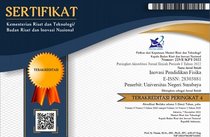PENGEMBANGAN LEMBAR KERJA SISWA (LKS) BERORIENTASI PROBLEM SOLVING PADA MATERI KALOR DI MAN 2 BOJONEGORO
Abstract
According to the curriculum KTSP, the purpose of learning high school physics is in addition to understand the concepts of physics students are also required to be able to use the scientific method, based on scientific attitude to solve a problem in daily life ( BSNP, 2006 ). However, the purpose of learning has not optimal in MAN 2 Bojonegoro. It can be seen from the existing problems in MAN 2 Bojonegoro among others: (1) students rarely be accustomed skill think so that mastery of the concept of students be weak. (2) students rarely given direct experience through lab work that knowledge students its working theoretical. And (3) less availability of worksheets (LKS, students). Shall perform a supporting of learning. Based on the study of pustaka that has been done, one effort to solve the problems in the top is the process of thinking by means of accustomed skill to the students. One of them is to help understanding the concept of students through solving a problem (the problem solving) implemented into LKS, through the development of LKS, oriented the problem solving. The aim of this research is to find out feasibility LKS, oriented solving problems related to the matter heat engine in MAN 2 Bojonegoro developed and to know response against LKS, the students. This research is research, development, with the target LKS, research is developed. A source of data obtained from the expert team includes lecturer and physics teacher as researcher and validator, as well as 15 graders X MAN 2 Bojonegoro. The design of this research is the development of which refers to 4-D (four D models) presented by Thiagarajan (1074). The result showed that worksheets students (LKS) as oriented the problem solving developed has fit for use in the learning process, because have met eligibility criteria based on the validation of conformity to a component of the problem solving.
Keywords: Student Worksheet, Problem Solving, Heat
Abstrak. Menurut Kurikulum KTSP, tujuan pembelajaran fisika di SMA adalah selain memahami konsep-konsep fisika siswa juga dituntut mampu menggunakan metode ilmiah yang dilandasi oleh sikap ilmiah untuk memecahkan masalah dalam kehidupan sehari-hari (BSNP, 2006). Namun, tujuan pembelajaran tersebut belum optimal di MAN 2 Bojonegoro. Hal ini dapat dilihat dari permasalahan yang ada di MAN 2 Bojonegoro antara lain: (1) Siswa jarang dilatihkan keterampilan berpikir sehingga penguasaan konsep siswa menjadi lemah. (2) Siswa jarang diberikan pengalaman langsung melalui praktikum sehingga pengetahuan siswa sebatas teoritis. Serta (3) kurang tersedianya Lembar Kerja Siswa (LKS). sebagai penunjang pembelajaran. Berdasarkan studi pustaka yang telah dilakukan, salah satu upaya untuk mengatasi permasalahan di atas adalah dengan cara melatihkan keterampilan proses berfikir kepada siswa. Salah satunya adalah membantu pemahaman konsep siswa melalui pemecahan masalah (problem solving) yang diimplementasikan ke dalam LKS, melalui pengembangan LKS Berorientasi problem solving. Tujuan penelitian ini adalah untuk mengetahui kelayakan LKS Berorientasi problem solving pada Materi Kalor di MAN 2 Bojonegoro yang dikembangkan dan untuk mengetahui respons siswa terhadap LKS tersebut. Penelitian ini merupakan penelitian pengembangan dengan sasaran penelitian adalah LKS yang dikembangkan. Sumber data diperoleh dari tim ahli meliputi dosen dan guru fisika sebagai penelaah dan validator, serta 15 siswa kelas X MAN 2 Bojonegoro. Rancangan penelitian ini adalah pengembangan yang mengacu pada 4-D (four D models) yang dikemukakan oleh Thiagarajan (1974). Hasil penelitian menunjukkan bahwa Lembar Kerja Siswa (LKS) berorientasi problem solving yang dikembangkan telah layak digunakan dalam proses pembelajaran, karena telah memenuhi kelayakan berdasarkan hasil validasi terhadap kriteria kesesuaian terhadap komponen problem solving.
Kata Kunci: Lembar Kerja Siswa, Problem Solving, Kalor. Abstract Views: 75
Abstract Views: 75 PDF Downloads: 244
PDF Downloads: 244










